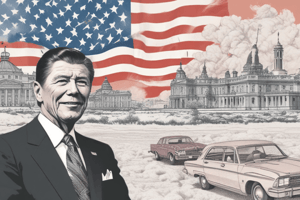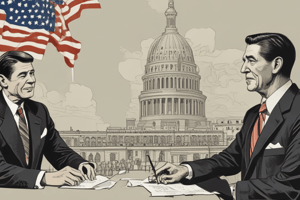Podcast
Questions and Answers
What was a primary objective of Ronald Reagan's foreign policy?
What was a primary objective of Ronald Reagan's foreign policy?
- To combat the spread of communism, especially from the Soviet Union. (correct)
- To decrease military spending and focus on domestic issues.
- To promote international trade agreements.
- To establish peaceful relations with all nations, regardless of political ideology.
What was the Strategic Defense Initiative (SDI) proposed by Reagan designed to do?
What was the Strategic Defense Initiative (SDI) proposed by Reagan designed to do?
- Increase economic aid to developing countries.
- Establish a global network of military bases.
- Create an anti-ballistic missile system in space. (correct)
- Promote cultural exchange programs with the Soviet Union.
What concept had the US been operating under during the Cold War, which created a delicate balance because both sides had nuclear capabilities?
What concept had the US been operating under during the Cold War, which created a delicate balance because both sides had nuclear capabilities?
- Mutually-Assured Destruction (MAD) (correct)
- Preventative War
- Flexible Response
- Massive Retaliation
What was the main objective of the plan that Reagan ordered his national security team to devise?
What was the main objective of the plan that Reagan ordered his national security team to devise?
What did Reagan nickname the MX missile?
What did Reagan nickname the MX missile?
National Security Decision Directive Number 32 (NSDD-32) included which method to achieve its objectives?
National Security Decision Directive Number 32 (NSDD-32) included which method to achieve its objectives?
What term is used to define wars that are started by a major power but continue without their direct involvement?
What term is used to define wars that are started by a major power but continue without their direct involvement?
What was the purpose of the US selling weapons to Iran from 1985-1987?
What was the purpose of the US selling weapons to Iran from 1985-1987?
Which Soviet leader implemented perestroika and glasnost?
Which Soviet leader implemented perestroika and glasnost?
The profits from the weapons' sales to Iran were used to fund which anti-communist group?
The profits from the weapons' sales to Iran were used to fund which anti-communist group?
Flashcards
Reagan's Foreign Policy Objective
Reagan's Foreign Policy Objective
To combat the spread and threat of communism, especially as it pertained to the Soviet Union.
Strategic Defense Initiative (SDI)
Strategic Defense Initiative (SDI)
A proposed defense system with the goal to create an anti-ballistic missile system in space to deter and counter any Soviet attacks.
NSDD-32: Reagan's "Economic War"
NSDD-32: Reagan's "Economic War"
Attacking critical Soviet institutions, such as technology and natural gas to decrease the economic value of the USSR.
B-2 Stealth Bomber
B-2 Stealth Bomber
Signup and view all the flashcards
MX Missile (Peacekeeper)
MX Missile (Peacekeeper)
Signup and view all the flashcards
Reagan Doctrine
Reagan Doctrine
Signup and view all the flashcards
Proxy Wars
Proxy Wars
Signup and view all the flashcards
Glasnost
Glasnost
Signup and view all the flashcards
Perestroika
Perestroika
Signup and view all the flashcards
Iran-Contra Affair
Iran-Contra Affair
Signup and view all the flashcards
Study Notes
- In 1981, Ronald Reagan became the 40th president of the United States.
- Reagan's foreign policy aimed to combat the spread of communism, especially from the Soviet Union.
- He returned the Cold War and U.S.-Soviet relations to priority status and initiated the largest military buildup in US history.
- Reagan authorized the Strategic Defense Initiative (SDI), an anti-ballistic missile system in space to deter Soviet attacks.
- Reagan believed the Soviet Union had gained the upper hand in the Cold War under President Carter but also felt communism had weakened.
- Reagan's Cold War policy pursued a hardline stance against communism, aiming to end and win the Cold War.
- The National Security Decision Directive Number 32 (NSDD-32) was the foundation for Reagan's Cold War policy, with the U.S. objectives regarding the Soviet Union and "economic war."
- NSDD-32 led to decreased technology access, reduction of Soviet resources, and decreased value of Soviet goods for the USSR.
- In 1981, Reagan announced plans to add weapons, including warheads, to the US defense arsenal and oversaw the development of new defense technology.
- The B-2 stealth bomber, developed in secret and equipped with thermonuclear weapons, completed its first flight in July 1989 and could fly under the radar with a range of at least 6,000 nautical miles.
- Reagan developed the MX missile, nicknamed "the Peacekeeper", and threatened to build more silos to store additional MX missiles if the Soviet government failed to agree to missile reduction agreements.
- The US had been operating under the theory of mutually-assured destruction (MAD) during the Cold War.
- Reagan pursued the Strategic Defense Initiative (SDI), nicknamed "Star Wars," as a defense against long-range Soviet missiles, but it was never achieved due to technological limitations and high costs.
- The Reagan Doctrine called for an anti-communist stance dependent on a strong military presence, to reduce communism to its weakest days and achieve "peace through strength."
- The Doctrine called for the US to support "freedom fighters" worldwide and deploy CIA operatives to execute clandestine activities against Soviet-supporting regional governments.
- The US and the Soviet Union engaged in proxy wars, where major powers' interests are fought for by others.
- Under Reagan, the US became engaged in "aggressive self-defense" from Lebanon.
- In 1986, Reagan ordered an attack on military targets in Libya.
- The US sent troops to Grenada to secure democracy against a Soviet-backed communist government.
- In Central America, the US covertly supported the Contras, a Nicaraguan rebel group, with military supplies.
- The US supported Afghan rebel fighters with weapons to fight the Soviet invasion of Afghanistan.
- In April 1988, a peace agreement was signed by Soviet leader Mikhail Gorbachev with the Afghanistan government.
- Gorbachev introduced perestroika (economic overhaul) and glasnost (openness) in 1986.
- Gorbachev was open to meeting with Reagan to discuss Soviet-US relations and reduce nuclear threats.
- From 1985-1987, the US government sold weapons to Iran to get American hostages released, with profits used to fund the Contras in Nicaragua, known as the Iran-Contra Affair.
- Congress had banned the sale of US weapons to Iran through a trade embargo, and the Contras were financing their war efforts with drug money.
- The Iran-Contra Affair led to scrutiny of the Reagan administration and left the president looking untrustworthy.
Studying That Suits You
Use AI to generate personalized quizzes and flashcards to suit your learning preferences.




